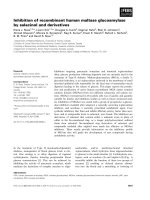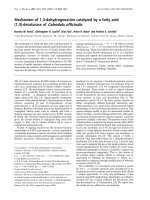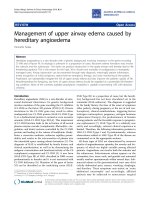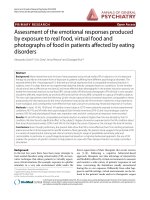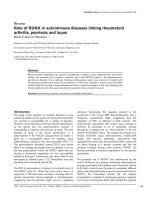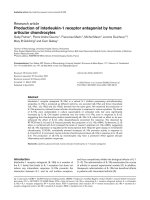Báo cáo y học: " Oncolysis of malignant human melanoma tumors by Coxsackieviruses A13, A15 and A18" pdf
Bạn đang xem bản rút gọn của tài liệu. Xem và tải ngay bản đầy đủ của tài liệu tại đây (351.92 KB, 6 trang )
SHOR T REPOR T Open Access
Oncolysis of malignant human melanoma tumors
by Coxsackieviruses A13, A15 and A18
Gough G Au
1,2*
, Leone G Beagley
2
, Erin S Haley
1
, Richard D Barry
1,2
, Darren R Shafren
1,3
Abstract
Many RNA viruses are displaying great promise in the field of oncolytic virotherapy. Previously, we reported that
the picornavirus Coxsackievirus A21 (CVA21) possessed potent oncolytic activity against cultured malignant
melanoma cells and melanoma xenografts in mice. In the present study, we demonstrate that thre e additional
Group A Coxsackieviruses; Coxsackievirus A13 (CVA13), Coxsackievirus A15 (CVA15) and Coxsackievirus A18 (CVA18),
also have similar oncolytic activity against malignant melanoma. Each of the viruses grew quickly to high titers in
cancer cells expressing ICAM-1 and intratumoral injection of preformed subcutaneous SK-Mel-28 xenografts in mice
with CVA13, CVA15 and CVA18 resulted in significant tumor volume reduction.
As preexisting immunity could potentially hinder oncolytic virotherapy, sera from stage IV melanoma patients and
normal controls were tested for levels of protective antibody against the panel of oncolytic Coxsackieviruses.
Serum neutralization assays revealed that 3 of 21 subjects possessed low levels of anti-CVA21 antibodies, while
protective antibodies for CVA13, CVA15 and CVA18 were not detected in any sample. Serum from individuals who
were seropositive for CVA21 failed to exhibit cross-neutralization of CVA13, CVA15 and CVA18. From these studies it
can be concluded that the administration of CVA13, CVA15 or CVA18 could be employed as a potential multivalent
oncolytic therapy against malignant melanoma.
Findings
Numerous viruses from a diverse range of virus families
are being identified for use as oncolytic virotherapy
agen ts. The underlying principle of oncolytic viroth erapy
is that the specificity of lytic viral infection can be har-
nessed to destroy malignant cells selectively, whilst leav-
ing normal host cells intact.Previouslywehaveshown
that Coxsackievirus A21 (CVA21) can selectively infect
and destroy in vitro cultures of malignant melanoma
cells that characteristically over-express intercellular
adhesion molecule-1 (ICAM-1) and/or decay accelerating
factor (DAF) [1, 2]. The genet ically unmodified prototype
CVA21 (Kuykendall strain) is also effective in vi vo, elimi-
nating tumor burden in NOD-SCI D mice bearing subcu-
taneous melanoma xenografts following a single injection
of virus [2].
Malignant melanoma is a cancer of the pigment produ-
cing cells of the skin (melanocytes), and arises from the
uncontrolled proliferation of these cells. Once the cancer
has metastasized, it is largely incurable, despite surgery
or treatment with intensive cycles of chemotherapy or
radiation therapy [3]. In an attempt to distinguish the cell
adhesion molecules involved in tumor progression and
metastasis, researchers have identified the cell surface
molecule ICAM-1, as a progression marker for metastatic
melanoma [4-7]. Concurrently, ICAM-1 is also recog-
nized as an attachment receptor for many enteroviruses
including CVA13, CVA15, CVA18 and CVA21 [8,9].
Functionally, the expression of the ICAM-1 receptor in
normal tissue allows for i) cellular contact between
neighboring ce lls, ii) signaling in inflammatory processes
and iii) the activation of the T-cell mediated host defense
system [10]. It is hypothesized that the over-expression
of ICAM-1 on melanoma cel ls may have a role in the
interference of normal immune function [10], as well as
assisting melanoma metastasis through cellular interac-
tions with circulating lymphocytes via the surface
expressed lymphocyte function-associated antigen-1
(LFA-1) integrin molecule [4,7,11,12].
As CVA21 is a naturally occurring virus that circulates
occasionally in the community, one concern regarding
* Correspondence:
1
The Picornaviral Research Unit, The School of Biomedical Sciences and
Pharmacy, Faculty of Health, The University of Newcastle, Newcastle,
New South Wales, 2300, Australia
Full list of author information is available at the end of the article
Au et al. Virology Journal 2011, 8:22
/>© 2011 Au et al; licensee BioMed Central Ltd. This is an Open Access article dis tributed under the terms of the Creative Commons
Attribution License ( y/2.0), which permits unrestricted use, distribution, and reproduction in
any medium, provided the original work is properly cited.
its use as an anti-cancer therapy is the presence of pre-
existing immunity in the recipient cancer patient. Infor-
mation concerning the epidemiology and prevalence of
CVA21 infection in the community is scanty, but a 1959
study in Great Britain found that 36.1% of males and
18.4% of females (inclusive of all age groups), possessed
serum antibodies to a virus i dentical to the Coe strain
of CVA21 [13]. The Coe strain was first isolated from
throat swabs of military recruits suffering from mild
acute respiratory illnesses in California [14], and is sero-
logically similar to the Kuykendall strain [13]. A mo re
recent study of enterovirus infections in Scottish blood
donors failed to detect amplifiable CVA21 template
from a total of 3658 pools of 95 donations tested, how-
ever these samples were not tested for neutralizing anti-
body status [15].
A potential strategy for successful ongoing ICAM-1 tar-
geted virotherapy that delays or avoids the impact of virus
neutralization, is to use a subset of Coxsackieviruses that
are serologically unrelated but that all recognize the same
cellular-uptake receptors. The three Coxsackie A group
viruses, CVA13, CVA15 and CVA18, were previously
shown to employ ICAM-1 for binding and cell infectivity
[8]. Based on these findings, CVA13, CVA15 and CVA18
were evaluated as potential candidates for the ICAM-1
targeted oncolytic therapy of malignant melanoma.
Coxsackievirus A13, CVA15, CVA18 and CVA21
belong to the C cluster of human enteroviruses (HEV-C),
and are members of the Picornaviridae family [16]. Picor-
naviruses are small icosahedral, non-enveloped viruses
that contain a single strand of positive sense RNA [17].
Clinically, the majority of human enterovirus infections
are asymptomatic [17]. While the Kuykendall strain of
CVA21 is frequently associated with the “common-cold”,
it is important to note that the prototype strains of
CVA13 (Flores), CVA15 (G-9) and CVA18 (G-13) were
originally isolated from stool samples of patients display-
ing no detectable illness [18].
In this study the oncolytic potential of CVA13,
CVA15 and CVA18 was established by using bot h
in vitro melanoma cultures, and in vivo melanoma xeno-
grafts. The frequency of CVA13, CVA15 and CVA18
infections in the community or the prevalence of speci-
fic-neutralizing antibody levels against these viruses in
individuals is difficult to predict due to a lack of sero-
epidemiological studies. We examined sera from mela-
noma patients with terminal d isease (n = 15) as well as
sera from healthy volunteers (n=6) for virus specific-
neutralizing antibody levels.
Lytic activity of CVA13, CVA15, and CVA18 in
in vitro melanoma cell culture
As a first approach, surface levels of ICAM-1 were
examined on the melanoma cell lines SK-Mel-28,
SK-Mel-RM, ME4405 and MV3. RD-ICAM -1 cells were
usedasapositivecontrol.Thiscelllinewasproduced
by the stable transfection of rhabdomyosarcoma cells
(RD) with cDNA encoding the ICAM-1 molecule and is
used as a reference cell line in our laboratory [9]. These
cells were maintained in DMEM containing 10% FCS
and harvested using versene prior to flow cytometry.
Commercially available PE-conjugated antibodies again st
ICAM-1 (ab1822) were obtained from Abcam. To assess
the surface expression of ICAM-1 on melanoma cells,
these antibodies were used together with Quanti-
BRITE™ PE beads (Becton Dickinson) according to
manufacturer’s instructions to determine the approxi-
mate number of antibodies bound per cell (ABC). Flow
cytometric analysis confirmed the presence of surface
ICAM-1 expression on the four melanoma cell lines
SK-Mel-28, SK-Mel-RM, ME4405 and MV3; and also
on the ICAM-1 transfected RD cells (Figure 1).
As CVA13, CVA15, and CVA18 utili ze ICAM-1 for
virus-cell entry, these viruses were evaluated for their
oncolytic activity against the panel of melanoma cells and
the control cell line RD-ICAM-1. Proto type strains of
Coxsackie A viruses (CVAs), CVA13 (Flores), CVA15
(G-9), CVA18 (G-13), CVA21 (Kuykendall) were
obtained from Dr M. Kennett. Confluent monolayers of
SK-Mel-28, ME4405, MV3, SK-Mel-RM and RD-ICAM-
1 cells in 96-well tissue culture plates were inoculated
with 10-fold serial viral dilutions (100 μl/well in quadru-
plicate) of either CVA21, CVA18, CVA15 or CVA13 and
incubatedat37°Cina5%CO
2
environment for 48 h.
Cytopathic effects (CPE) at eac h dilution was examined
by microscopy and fifty percent viral endpoint titers cal-
culated using the Karber method [19]. CVA21 exhibited
potent lytic activity, such that monolayers of SK-Mel-28
RD-ICAM-1
SK-Mel-28
SK-Mel-RM
ME4405
MV3
0
100
200
300
400
500
600
700
Unstained contro
l
ICAM-1
M
e
l
a
n
o
m
a
ce
ll lin
es
ABC x 10
3
Figure 1 ICAM-1 expression on SK-Mel-28, ME4405 and
RD-ICAM-1 cells. Quantitative flow cytometric analysis of virus-entry
receptor ICAM-1 expression on melanoma cell lines SK-Mel-28,
SK-Mel-RM, ME4405, MV3; and ICAM-1 transfected RD cell line
(RD-ICAM-1). The level of ICAM-1 antibodies bound per cell (ABC)
are denoted by the white bars whereas the unstained control is
shown in black.
Au et al. Virology Journal 2011, 8:22
/>Page 2 of 6
cells were destroyed even at a level of approximately
0.001 TCID
50
/cell (Figure 2). The subset of viruses,
CVA13, CVA15 and CVA18 displayed comparabl e levels
of oncolytic activity on SK-Mel-28 monolayers. SK-Mel-
RM, ME4405 and MV3 cells when infected with the
panel of CVAs also demonstrated rapid cell death, how-
ever higher concentrations of virus were required com-
pared to the RD-ICAM-1 and SK-Mel-28 cell lines.
CVA13, CVA15 and CVA18 exhibit similar
replication profiles in RD-ICAM-1 cells and
melanoma cell lines SK-Mel-28 and ME4405
The viral replication rate and release of progeny virus
from infected tumor cells are important factors for suc-
cessful oncolytic virotherapy. We sought to determine
the growth properties of the Coxsackie A virus subset
(CVA13, CVA15 and CVA18) in SK-Mel-28, ME44 05
and RD-ICAM-1 cells compared to human PBMCs.
Human peripheral blood mononuclear cells (PBMCs)
were isolated from he althy adults by Ficoll-Paque gradi-
ents and cultured i n RPMI media with 10% FCS. For the
adherent cell lines, confluent cell monolayers in 6-well
plates were infected with approximately 10
6
TCID
50
of
CVA13, CVA15 or CVA18 (multiplicity of infection
(MOI) ~ 1 TCID
50
/cell). The plat es were incubated for 1
hr at 37°C, then washed 3 times each with DMEM and
the monolayers overlaid with 3 ml of DMEM containing
2% FCS before incubating at 37°C. Synchronized infec-
tion was interrupted at time intervals of 0, 2, 4, 6, 8, 10,
12, 24 and 48 hours. The cell monolayers were lysed by
three consecutive freeze-thaw cycles before the viral yiel d
in the cell lysate was determined in an endpoint titration
assay.
The growth of the three CVAs in PBMCs was carried
out in suspension and these cells were infected at a
MOI of 1 TCID
50
/cell with either CVA13, CVA15 or
CVA18. Virus was allowed to bind for 1 hour prior to
washing three times with RPMI media (2% FCS). For
each virus, the infected PBMCs were then divided into
four tubes with approximately 8.5 × 10
5
cells per tube
in a final volume of 500 μlofRPMI(2%FCS).These
infected cells were then incubated at 37°C and total cell
suspensions at 0, 12, 24 and 48 hours were lysed by
three c onsecutive freeze -thaw cycles before being
titrated to determine virus yield.
ThegrowthcurvesrevealedthatCVA13,CVA15and
CVA18 underwent exponential replication between 4
and 6 hours, and reached maximal titers in SK-Mel-28,
ME4405 and RD-ICAM-1 within 12 hours post infection
(Figure 3A,B and 3C). Irrespective of the different tumor
cell lines, CVA13, CVA15 and CVA18 displayed simil ar
replication rates and yielded increases in virus output by
approximately 10
4
fold. As CVA21 spreads via the sys-
temic circulation after virus thera py of in vivo mela-
noma tumors [2], we investigated the likelihood that
human PBMCs could be exposed to viral challenge.
Normal PBMCs how ever, were refractile to viral infec-
tion, exhibiting no exponential increase in CVA13,
CVA15 or CVA18 titers compared to those seen in
the SK-Mel-28, ME4405 or RD-ICAM-1 cell lines
(Figure 3). Flow cytometric analysis revealed low levels
of ICAM-1 on the surface of PBMCs and upon further
incubation with virus for 6 days, no increase in virus
yields were detected (data not shown).
CVA13, CVA15 and CVA18 effectively reduce
tumor volumes of subcutaneous SK-Mel-28
xenografts in a SCID mouse model
To evaluate the potential use of these viruses for the con-
trol of melanoma tumor progression in vivo, preformed
SK-Mel-28 tumors (~ 150 mm
3
) on the hind flank of
SCID mice, were directly injected with a single dose of
either PBS, live CVA 13, CVA15 or CVA18 (~ 10
5
TCID
50
). All animal work was performed under guide-
lines approved by The University of Newcastle Animal
Care and Ethics Committee. SK-Mel-28 cells grown in
DMEM containing 10% FCS, were harvested, washed
twice with DMEM, and resuspended in sterile PBS.
Tumor cells were xenografted into the flanks of anaesthe-
tized4-6weekoldfemaleSCIDmicebysinglesubcuta-
neous injections of 1 × 10
6
cells (n = 20). Once solid
palpable tumors were established, the animals were
divided into four treatment groups, each animal receiving
either intratumoral injectio ns of PBS (0.1 ml), CVA18,
CVA15 or CVA13 (0.1 ml containing approximately
RD-ICAM-1
SK-Mel-28
SK-Mel-RM
ME4405
MV3
0.0001
0.001
0.01
0.1
1
10
100
CVA21
CVA18
CVA1
5
CVA13
M
e
l
a
n
o
m
a
ce
ll lin
es
TCID
50
/cell
Figure 2 Destruction of melanoma cells by CVA13, CVA15,
CVA18 and CVA21. Cultures of SK-Mel-28, SK-Mel-RM, ME4405,
MV3 and RD-ICAM-1 monolayers were infected with 10-fold serial
dilutions of virus ranging from 1:10 to 1:10
7
. After incubation for 48
h, the plates were fixed and stained with a crystal violet/methanol
and TCID
50
/cell required to induce monolayer destruction was
calculated. SK-Mel-28 and RD-ICAM-1 were the most sensitive lines
to the panel of CVAs requiring only low concentrations of virus to
achieve cell lysis.
Au et al. Virology Journal 2011, 8:22
/>Page 3 of 6
10
5
TCID
50
units). Melanoma xenograft growth was
monitored weekly with calipers and averages of tumor
volumes (based on the volume of a spheroid) from each
treatment group were plotted ± standard error.
Significant reductions in tumor v olumes were observed
35 days post CVA13, CVA15 and CVA18 treatment com-
pared to the PBS treated control group (One-way
ANOVA, P <0.01forbothCVA18andCVA15vs.PBS,
P < 0.05 for CVA13 vs. PBS group) (Figure 4). The
groups of animals receiv ing CVA13, CVA15 and CVA18
intratumoral therapy failed to display any further
increases in tumor volumes even up to 48 days post
treatment. In contrast the tumors of PBS treated mice
steadily increased, with animals from this group being
euthanized at 35 days post treatment due to ethical con -
siderations. CVA18 appeared to be rapidly effective
against preformed SK-Mel-28 tumors, with aggressive
tumor reduction leading to the complete clearance of
tumors (5/5 mice tumor free), compared to CVA15 (2/5
mice tumor free) and CVA13 (0/5 tumor free) at day 48
post treatment. CVA13 was much slower to induce anti-
tumor activity against the preformed SK-Mel-28 tumors
and failed to induce complete tumor regression despite
showing initial signs of tumor reduction.
Levels of serum neutralizing antibodies
to CVA13, CVA15, CVA18 and CVA21 in
melanoma patient sera
To gauge the extent to which melanoma patients may
have been naturally exposed to CVA21, CVA13, CVA15
and CVA18, fifteen late stage melanoma patients and six
healthyvolunteersweretestedforthepresenceofvirus
specific neutralizing antibodies. Heat inactivated serum
samples were diluted in DMEM (2% FCS) 1:4 to 1:256.
One hundred microliters of each serum dilution
was incubat ed with 100 μL of each respective virus
(100 TCID
50
of either CVA21, CVA18, CVA15 or
CVA13) at 37 °C for 1 hour. Two hundred microliters of
this serum/virus mixture was then plated in triplicate on
0 1020304050
10
0
10
1
10
2
10
3
10
4
10
5
10
6
10
7
10
8
10
9
10
10
PBMC
RD-ICAM-1
SK-Mel-28
ME4405
Time post infection (h)
CVA13 titer (TCID
50
/ml)
0 1020304050
10
0
10
1
10
2
10
3
10
4
10
5
10
6
10
7
10
8
10
9
10
10
PBMC
RD-ICAM-1
SK-Mel-28
ME4405
Time post infection (h)
CVA15 titer (TCID
50
/ml)
0 1020304050
10
0
10
1
10
2
10
3
10
4
10
5
10
6
10
7
10
8
10
9
10
10
PBMC
RD-ICAM-1
SK-Mel-28
ME4405
Time post infection
(
h
)
CVA18 titer (TCID
50
/ml)
ABC
Figure 3 Growth curves of CVA13, CVA15 and CVA18 in SK-Mel-28, M E4405 and RD-ICAM-1 cells compared to PBMCs . SK-Mel-28,
ME4405, RD-ICAM-1 and PBMCs were challenged with CVA13 (A), CVA15 (B) or CVA18 (C) for 1 h, and after the removal of unbound virus, cells
and media were collected at the indicated time points for assessment of virus progeny by endpoint titration.
020406
0
0
200
400
600
800
1000
PBS
CVA18
CVA13
CVA15
*
**
**
Da
y
s post treatment
Tumor Volume (mm
3
)
Figure 4 SK-Mel-28 tumors are responsive to intratumoral
CVA13, CVA15 and CVA18 therapy in SCID mice. Severe
combined immunodeficient (SCID) mice bearing preformed s.c.
tumors (approximately 150 mm
3
) growing on the flanks after
injection of 1 × 10
6
SK-Mel-28 cells, received an intratumoral
injection with a single dose of CVA13, CVA15, CVA18 (10
5
TCID
50
)or
PBS (n = 5 for each group). The average relative tumor sizes were
measured externally with calipers and are expressed as the means
of five treated mice ± S.E. * and ** indicate statistical significance of
tumor volumes compared to the control, P < 0.05 and P < 0.01
respectively (One-way ANOVA).
Au et al. Virology Journal 2011, 8:22
/>Page 4 of 6
SK-Mel-28 cells. As a control, two commercially available
stocks of pooled gamma globulin (Commonwealth Serum
Laboratories, Victoria, Australia) were tested for neutra-
lizing antibodies against CVA13, CVA15, CVA18 and
CVA21 as per the above protocol. Plates were incubated
for 3 days, then examined microscopically for the devel-
opment of CPE, and then stained with crystal violet/for-
malin. The neutralization titers were calculated using the
Karber method [19], with serum neutralizing titers > 1:4
considered to be positive.
Pre-existing neutralizing antibodies against CVA13,
CVA15 or CVA18 were not detected in the serum of
the melanoma patients, healthy volunteers, or the
commercial pooled-IgG preparation (Table 1). Three
of the fifteen melanoma patients demonstrated circu-
lating CVA21 antibody titers >1:4, while no detectable
levels of CVA21 antibodies were found in the serum
of the healthy control group. Serum from patients
who were positive for CVA21 neutralizing antibodies,
failed to offer cross-protective neutralization against
CVA13, CVA15 or CVA18. The two samples of com-
mercial pooled-immunoglobulin IgG, neutralized 100
TCID
50
of CVA21 but not CVA13, CVA15 or CVA18
(Table 1). As the normal pooled immunoglobulin is
prepared from a diverse population of healthy blood
donors, these data support the postulate that natural
CVA13, CVA15 and CVA18 inf ections are uncommon
in the community.
Conclusions
Coxsackieviruses A13, CVA15 and CV A18 are an enter-
oviral subset that potentially may be used to destroy
malignant melanoma tumor cells because their entry
receptor ICAM-1 is abundantly expressed on the surface
of melanoma cells. In vitro and in vivo findings in the
present study confirms the successful targeting of
human melanoma cells and induction of tumor lysis by
CVA13, CVA15 and CVA18.
The role of the immune system in preventing the sys-
temic traffic of oncolytic viruses is a potential impediment
to the development of effective virotherapy strategies. The
presence of specific neutralizing antibodies that prevent
virus attachment and infection may therefore limit suc-
cessful virotherapy. An important outcome of this study
was that neutralizing antibodies to CVA13, CVA15 and
CVA18 were not detected in any of the melanoma patient
samples tested, and those that were seropositive to
CVA21, failed to cross-pr otect against CVA13, CVA15
and CVA18 challenge.
Our findings suggest that the mildly pathogenic viruses
CVA13, CVA15 and CVA18, are potent oncolytic agents
and viable candidates for a sequential multivalent viral
oncolytic therapy. As a treatment strategy, sequential
infection by these similar but serologically distinct CVAs
may be a realistic means of circumventing the impact of
anti-viral ne utralizing antibodies.
Abbreviations
CPE: Cytopathic Effect; CVA13: Coxsackievirus A13; CVA15: Coxsackievirus
A15; CVA18: Coxsackievirus A18; CVA21: Coxsackievirus A21; DMEM:
Dulbeccco Modified Eagle’s Medium; FCS: Fetal Calf Serum; MOI: Multiplicity
of Infection; PBMCs: peripheral blood mononuclear cells; RPMI: Roswell Park
Memorial Institute.
Acknowledgements
We would like to acknowledge the support of Cure Cancer Australia
Foundation and Cancer Australia.
Author details
1
The Picornaviral Research Unit, The School of Biomedical Sciences and
Pharmacy, Faculty of Health, The University of Newcastle, Newcastle,
New South Wales, 2300, Australia.
2
Newcastle Innovation Ltd, Industry
Development Centre, University Drv, Callaghan, New South Wales, 2308,
Australia.
3
Viralytics Ltd, Suite 1B, 55-63 Grandview St, Pymble, New South
Wales, 2073, Australia.
Authors’ contributions
DRS and GGA designed the research. GGA performed the experimental
work, conducted the data analysis and drafted the manuscript. LGB and ESH
contributed to the testing of patient samples. All participated in the review
of the manuscript. All authors read and approved the final manuscript.
Competing interests
Darren R. Shafren is a director of Viralytics Ltd.
Richard D. Barry and Darren R. Shafren declare a financial interest in Viralytics
Ltd.
Received: 16 December 2010 Accepted: 18 January 2011
Published: 18 January 2011
Table 1 Serum neutralization titers to CVA13, CVA15 and CVA18
Sample group No. sera No. CVA13-positive (%) No. CVA15-positive (%) No. CVA18-positive (%) No. CVA21-positive (%)
Commercial immune globulin 2 0 (0) 0 (0) 0 (0) 2 (100)
Melanoma 15 0 (0) 0 (0) 0 (0) 3 (20.0)
Control 6 0 (0) 0 (0) 0 (0) 0 (0.0)
Total patients 21 0 0 0 3 (14.3)
Fifteen melanoma patients were examined for serum neutralization of CVA21, CVA13, CVA15 and CVA18. Heat inactivated serum samples were diluted serially,
and then titrated against 100 TCID
50
(CVA21, CVA13, CVA15 and CVA18) to assess neutralization status. Fifty percent neutralization scores of 1:4 or above
calculated by the Karber method [19], were considered to be positive for neutralization status. Six healthy volunteers were also assessed for serum neutralizing
antibodies against CVA13, CVA15 and CVA18, all of which were below 1:4 (50% neutralization score). Two commercially available immune serum globulin
samples were also tested for neutralizing capacity.
Au et al. Virology Journal 2011, 8:22
/>Page 5 of 6
References
1. Au GG, Lindberg AM, Barry RD, Shafren DR: Oncolysis of vascular
malignant human melanoma tumors by Coxsackievirus A21. Int J Oncol
2005, 26:1471-1476.
2. Shafren DR, Au GG, Nguyen T, Newcombe NG, Haley ES, Beagley L,
Johansson ES, Hersey P, Barry RD: Systemic therapy of malignant human
melanoma tumors by a common cold-producing enterovirus,
coxsackievirus a21. Clin Cancer Res 2004, 10:53-60.
3. Shokrollahi K, Whitaker I: Malignant melanoma: perspectives, diagnostics
and treatment. Ann Plast Surg 2010, 64:132-133.
4. Johnson JP: Cell adhesion molecules in the development and
progression of malignant melanoma. Cancer Metastasis Rev 1999,
18:345-357.
5. Johnson JP, Stade BG, Holzmann B, Schwable W, Riethmuller G: De novo
expression of intercellular-adhesion molecule 1 in melanoma correlates
with increased risk of metastasis. Proc Natl Acad Sci USA 1989, 86:641-644.
6. Johnson JP, Stade BG, Hupke U, Holzmann B, Schwable W, Reithmuller G:
The melanoma progression-associated antigen P3.58 is identical to the
intercellular adhesion molecule ICAM-1. Immunobiology 1988,
178:275-284.
7. Hamai A, Meslin F, Benlalam H, Jalil A, Mehrpour M, Faure F, Lecluse Y,
Vielh P, Avril MF, Robert C, Chouaib S: ICAM-1 has a critical role in the
regulation of metastatic melanoma tumor susceptibility to CTL lysis by
interfering with PI3K/AKT pathway. Cancer Res 2008, 68:9854-9864.
8. Newcombe NG, Andersson P, Johansson ES, Au GG, Lindberg AM, Barry RD,
Shafren DR: Cellular receptor interactions of C-cluster human group A
coxsackieviruses. J Gen Virol 2003, 84:3041-3050.
9. Shafren DR, Dorahy DJ, Ingham RA, Burns GF, Barry RD: Coxsackievirus A21
binds to decay-accelerating factor but requires intercellular adhesion
molecule 1 for cell entry. J Virol 1997, 71:4736-4743.
10. van de Stolpe A, van der Saag PT: Intercellular Adhesion Molecule-1.
Journal of Molecular Medicine 1996, 74:13-33.
11. Miller BE, Welch DR: Cytokine modulation of intercellular adhesion
molecule-1 surface expression on human melanoma cells: correlation
with adhesion of peripheral blood leukocytes. Proc Amer Assoc Cancer Res
1990, 31:353.
12. Yamada M, Yanaba K, Takehara K, Sato S: Clinical significance of serum
levels of soluble intercellular adhesion molecule-1 and soluble L-selectin
in malignant melanoma. Arch Dermatol Res 2005, 297:256-260.
13. Pereira MS, Pereira HG: Coe virus. Properties and prevalence in Great
Britain. Lancet 1959, 2:539-541.
14. Lennette EH, Fox VL, Schmidt NJ, Culver JO: The Coe virus, an apparently
new virus recovered from patients with mild respiratory disease. Amer J
Hyg 1958, 68
:272.
15. Welch J, Maclaran K, Jordan T, Simmonds P: Frequency, viral loads, and
serotype identification of enterovirus infections in Scottish blood
donors. Transfusion 2003, 43:1060-1066.
16. King AMQ, Brown F, Christian P, Hovi T, Hyypiä T, Knowles NJ, Lemon SM,
Minor PD, Palmenberg AC, Skern T, Stanway G: Picornaviridae. In Virus
Taxonomy. Seventh Report of the International Committee for the Taxonomy
of Viruses. Edited by: Van Regenmortel MHV, Fauquet CM, Bishop DHL,
Calisher CH, Carsten EB, Estes MK, Lemon SM, Maniloff J, Mayo MA,
McGeoch DJ, Pringle CR, Wickner RB. New York, San Diego: Academic Press;
2000:657-673.
17. Rueckert RR: Picornaviridae: The Viruses and Their Replication. In Fields
Virology. Edited by: Fields BN, Knipe DM, Howley PM. Philadelphia:
Lippincott-Raven; 1996:609-645.
18. Pallansch MA, Roos RP: Enteroviruses: Polioviruses, Coxsackieviruses,
Echoviruses, and Newer Enteroviruses. In Fields Virology. Edited by: Knipe
DM, Howley PM, Griffin DE, Lamb RA, Martin MA, Roizman B, Straus SE.
Philadelphia: Lippincott Williams 2001:723-776.
19. Dougherty RM: Animal virus titration techniques.Edited by: Harris RJC.
New York: Academic Press; 1964:169-223.
doi:10.1186/1743-422X-8-22
Cite this article as: Au et al.: Oncolysis of malignant human melanoma
tumors by Coxsackieviruses A13, A15 and A18. Virology Journal 2011
8:22.
Submit your next manuscript to BioMed Central
and take full advantage of:
• Convenient online submission
• Thorough peer review
• No space constraints or color figure charges
• Immediate publication on acceptance
• Inclusion in PubMed, CAS, Scopus and Google Scholar
• Research which is freely available for redistribution
Submit your manuscript at
www.biomedcentral.com/submit
Au et al. Virology Journal 2011, 8:22
/>Page 6 of 6

